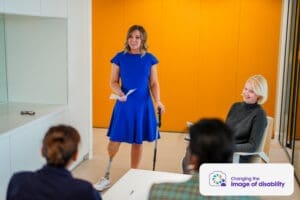Changing the image of disability: why authentic representation is so important for the disabled community
Lucy Ruck, BDF’s Taskforce Manager, talks about our Changing the image of disability campaign.
How often do you see yourself? I’m not talking about seeing yourself in a mirror, but see yourself represented in media, advertising and marketing? Until the Paralympics, I’d never really seen an amputee/person with a prosthetic, unless it was in a medical drama! Things are changing.
I can think of a number of adverts in the last few years that have included amputees, and I even saw an amputee in a window display in a local fast-food restaurant last week. But I can’t really say the same for business and the workplace. There are some images out there, and I know that some companies are really thinking about this, but we’re not quite there. We want a range of disabled people in the images used and wouldn’t it be great if we could include people with less immediately obvious conditions, such as ADHD and dyslexia? Trickier to do but possible.
Business Disability Forum has created a Disability Smart Image Bank with nearly 500 authentic images for our Members and Partners to use, along with some practical guidance on what to think about when you use, select or commission images. Our campaign is all about changing the image of disability, improving how disabled people and disability is portrayed.

When I heard about this project, I knew I wanted to be a part of it. So, back in the summer, I headed down to London to be a ‘model’ in one of the photoshoots alongside other volunteers and professional disabled models. We often talk about being authentic in the world of disability, and this photoshoot absolutely encompassed this. The diversity of the models was a joy, covering so many aspects of disability and the production team really wanted to keep it authentic, asking throughout “is this something you would do in real life?”. There were no gimmicks, just disabled people, bringing their own props/aids along, that they use, day in, day out to make sure the images were real.
And I could see the ripple effect of this. I know (because I was chatting to them about it) that the photographer and the wider team will think more about disability and inclusion in their future work, including recommending clients are more disability inclusive in their shoots. The models will be more confident in ‘keeping it real’, and providing push back in future when something just doesn’t feel right.
Authentic representation challenges the idea of a one-size-fits-all narrative. Disabilities are as diverse as the individuals who live with them. Authentic images capture this diversity, showcasing the unique strengths, talents, and perspectives within the disabled community. This not only combats stereotypes but also contributes to a more accurate and nuanced portrayal of the rich tapestry of human experience.
In essence, the push for authentic representation in images is a call for a more inclusive, understanding, and compassionate world. It’s a recognition that diversity should be celebrated, not just acknowledged. Shouldn’t your company communications represent the people you employ, as well as the diverse people you want to attract?
So, let’s continue advocating for a world where everyone sees themselves authentically reflected in the images around us.
Find out more about the Changing the image of disability campaign.